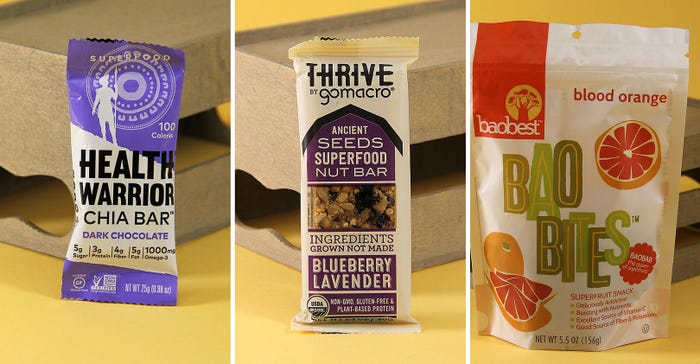Unboxed: 'Superfood' marketing skyrockets

An impressive mashup of USDA Organic ingredients, including almonds, carrot, wheatgrass, maca, spinach, green tea and so much more. Surprisingly, the flavor is rather palatable. Each bar delivers 220 calories and 6 grams protein—not bad for a light meal replacement. amazinggrass.com
These totally addictive little jelly squares are like the healthy version of those goo-filled gummies, ‘Gushers,’ from my childhood. Packed with fruits like apple and pomegranate concentrates, organic baobab fruit powder (which is rich in antioxidants and fiber), pectin, natural flavoring, rice bran, added vitamin C and vegetable juice for a kid-friendly tint. baobabfoods.com
In this Non-GMO Project verified, Certified Gluten-Free bar, chia seeds deliver 4 grams of fiber, 1,000 mg of omega-3s and 3 grams of protein. Also inside: brown rice syrup, cashew butter, rolled oats, almonds, organic dark chocolate and more. healthwarrior.com
A lunchbox-perfect pouch filled with 100 calories, 5 grams of protein and 20 percent of your Daily Value of calcium, thanks to USDA Organic ingredients including skim milk, strawberry and blueberry puree, cane sugar, pectin and natural flavors. Yum! horizondairy.com
We dig Larabar’s new line of organic bars that infuse superfoods like coconut, hemp, kale, ginger, beet, turmeric and cacao into their signature fruit and nut bars. Sweetened just with dates, these take-along bars win in clean, simple ingredients. larabar.com
I don’t know how these healthful crackers, made with a smattering of nutrient-dense ingredients like USDA Organic whole grain brown rice, quinoa, pumpkin seeds, flax, poppy seeds and even seaweed, hold together, but they’re sturdy enough to stand up to even the heaviest of dips. marygonecrackers.com
A gluten-free snack bar that boasts nine superfoods, this maca-infused nosh also contains organic cashews, brown rice, roasted sunflower seeds, cacao nibs, quinoa crisps, amaranth seeds, maple syrup and even lucuma, a fruit. All for 180 calories and sweet-chewy deliciousness. navitasnaturals.com
This just might be a truly healthy chocolate bar. At just 3 grams sugar per serving, this company combines raw, organic Ecuadorian cacao paste with coconut nectar, cacao butter, yacon syrup, cacao powder, Peruvian lucuma, peppermint oil, Madagascar vanilla beans and sea salt. Pretty impressive. ultimatesuperfoods.com
We’re a big fan of these perfectly chewy, deliciously awesome bars, which include organic walnuts, sunflower seeds, gluten-free rolled oats, blueberries, lemon, organic lavender and more. Bonus: They're also vegan! gomacro.com
We’re a big fan of these perfectly chewy, deliciously awesome bars, which include organic walnuts, sunflower seeds, gluten-free rolled oats, blueberries, lemon, organic lavender and more. Bonus: They're also vegan! gomacro.com
From crackers to nutrition bars to chocolate, it seems like a lot of brands use some derivative of the word “superfood” on product packaging. There technically isn’t an agreed-upon definition for this ubiquitous word--the FDA doesn’t have a list of tested and approved superfoods, and most attempts to scientifically rank nutrient-dense foods have fallen short.
The ORAC (Oxygen Radical Absorbing Capacity) value, for example, measures the antioxidant capacity of foods, i.e. the ability of foods to eliminate free radicals. Foods with high ORAC based on a typical serving include red wine, baking chocolate, pomegranate juice, apples, blueberries and more. But ORAC is just one aspect of health—a diet of wine, chocolate and juice is obviously not “super.”
So if they’re not talking about ORAC, then what do brands mean when they print this ubiquitous term on packaging?
Packaging expert Blake Mitchell, president of the food marketing firm Interact, likens "superfood" labeling to "natural," and he's definitely seeing the term grow in popularity.
"While the true definition of a superfood has always been a bit gray, I think the marketing term 'superfood' is peaking and will soon hold the same meaning as 'all natural,'" he says. "This isn't necessarily a bad thing if the actual product is good. We are all for consumers eating healthier, and if certain terms like 'all natural' and 'superfood' become purchase drivers and will help them achieve this, then, amen!"
Here, find a small sampling of products that tout their "super" status loud and proud.
Read more about:
UnboxedAbout the Author(s)
You May Also Like




